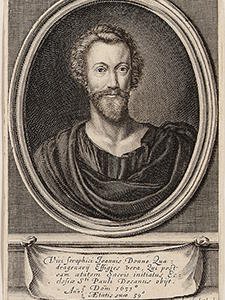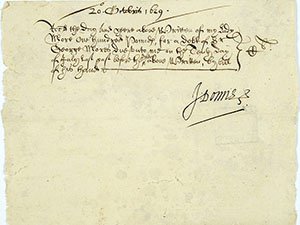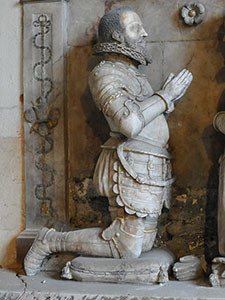 Poet of startlingly powerful poetry, darkly witty, exuberant, grotesque, uplifting: John Donne is recognised as among the greatest writers in English. Donne’s life story has important connections to Surrey, and a number of his letters to his wife Anne’s family, the Mores of Loseley near Guildford, were formerly part of the Loseley Manuscripts. The letters, thought to be the Donne documents in the collection, were sold to the Folger Shakespeare Library in the USA in 1940. It was only when the Loseley Manuscripts were more systematically catalogued, that an overlooked remaining piece of evidence of Donne was found.
Poet of startlingly powerful poetry, darkly witty, exuberant, grotesque, uplifting: John Donne is recognised as among the greatest writers in English. Donne’s life story has important connections to Surrey, and a number of his letters to his wife Anne’s family, the Mores of Loseley near Guildford, were formerly part of the Loseley Manuscripts. The letters, thought to be the Donne documents in the collection, were sold to the Folger Shakespeare Library in the USA in 1940. It was only when the Loseley Manuscripts were more systematically catalogued, that an overlooked remaining piece of evidence of Donne was found.
Donne was no national treasure in 1602, when the young man revealed to Sir George More of Loseley that he and More’s daughter had secretly married. Donne had met teenaged Anne in the London household of her aunt, Sir George’s sister Elizabeth, Lady Egerton, where he worked as Lord Egerton’s secretary. His letter justifying the couple’s deception is compulsively clever, seemingly oblivious that he is unlikely to placate the father with a neat pun: ‘yt ys irremediably donne’ (‘it is irremediably done’).
Sir George was in 1602 at the height of success. He was wealthy, respected, and ambitious for further promotion in the anticipated Jacobean government. He was enraged by Donne’s news. Donne was arrested and briefly imprisoned in the Fleet Prison while Sir George considered charges against him. Donne had not been entirely foolish, as he secured a judgement confirming the validity of the marriage under church law. Sir George dropped his case but initially refused to give Anne a dowry. Thus the couple spent most of the life they had together in embarrassed circumstances: Lord Egerton would no longer employ Donne, nor could he gain another position after such a betrayal of trust. The Donnes lived first at Pyrford Place, home of Anne’s cousin Francis Wolley, and then in Mitcham, probably with the help of Anne’s sister Mary Carew.
Sir George received, and kept, letters from Donne to the Mores. Although the men were reconciled in later years, most of the surviving letters arose from Donne’s imprisonment and prospective prosecution. The letters depict the despair which haunted Donne, and would do for many years:
‘though I be not headlongly destroyed, I languish, and rust dangerously’ (Donne to More, Folger L.b.532).
Only after assenting to seek a career in the Church of England and gaining the patronage of King James I did Donne achieve financial security and status. Ultimately, he was Dean of St Paul’s Cathedral, the grandest edifice in the City of London.
 Donne became highly celebrated as a preacher during his lifetime, but his poetry was mostly printed for publication only after his death. His ‘Metaphysical’ style was unpopular by the 18th century, though he continued to be known as Dr Donne, writer of sermons. However, he was revived during the era of Modernist poetry in the early 20th century, so when letters by and relating to Donne among the archive of Loseley House were to be offered for sale in 1939, the British Museum considered them of such importance that it attempted a fundraising campaign to buy them. On the verge of war, with the British public moved by the plight of refugees from mainland Europe, there was little support for saving manuscripts. The letters crossed the Atlantic, avoiding the Blitz, and were eventually bought by the Folger Shakespeare Library, Washington DC.
Donne became highly celebrated as a preacher during his lifetime, but his poetry was mostly printed for publication only after his death. His ‘Metaphysical’ style was unpopular by the 18th century, though he continued to be known as Dr Donne, writer of sermons. However, he was revived during the era of Modernist poetry in the early 20th century, so when letters by and relating to Donne among the archive of Loseley House were to be offered for sale in 1939, the British Museum considered them of such importance that it attempted a fundraising campaign to buy them. On the verge of war, with the British public moved by the plight of refugees from mainland Europe, there was little support for saving manuscripts. The letters crossed the Atlantic, avoiding the Blitz, and were eventually bought by the Folger Shakespeare Library, Washington DC.
After the war, an archivist catalogued the Loseley Manuscripts still in Surrey. Among an enormous quantity of bills and receipts, unexpectedly she encountered one of October 1629 from Donne. The receipt is written by a clerk, recording the slightly late repayment by Lady More of a debt of £100 owed by Sir George More to his now wealthy son in law. ‘J Donne’ has signed in acknowledgement with his distinctive large J, stunted capital D and concluding Greek style ‘e’ with flourish.
 Donne’s very visible rise had occurred as Sir George More declined. More was ill-favoured by the Crown, and failed to manage the commitments of a wealthy gentleman. Donne in fact refers to the £100 loan in a curious surviving letter, apparently asking for the money before its due date, and bizarrely perhaps jokingly suggesting that he may need to alter his will, depriving his ‘other children’ of their inheritance, if it is unpaid (Folger L.b.542). Sir George is not well-regarded by Donne aficionados, for his harsh reaction to what he saw as Donne’s presumptuous entry into the rich More family, but Sir George was otherwise known as generous to the point of folly: ‘he was ever more ready and willing to do courtesies for others than for himself’, commented another son-in-law, Sir John Oglander.
Donne’s very visible rise had occurred as Sir George More declined. More was ill-favoured by the Crown, and failed to manage the commitments of a wealthy gentleman. Donne in fact refers to the £100 loan in a curious surviving letter, apparently asking for the money before its due date, and bizarrely perhaps jokingly suggesting that he may need to alter his will, depriving his ‘other children’ of their inheritance, if it is unpaid (Folger L.b.542). Sir George is not well-regarded by Donne aficionados, for his harsh reaction to what he saw as Donne’s presumptuous entry into the rich More family, but Sir George was otherwise known as generous to the point of folly: ‘he was ever more ready and willing to do courtesies for others than for himself’, commented another son-in-law, Sir John Oglander.
The men died within a year of each other. Donne’s will, now among the ‘famous wills’ series in the National Archives, proudly distributes the material riches of his worldly life, while Sir George died intestate and in debt. Our single bill is a telling remnant of the conjunction of this remarkable man with the Mores, and their strangely intertwined fortunes.
Sources
For an edition of Donne’s letters and the story of their purchase by the Folger Shakespeare Library, see editors. M Thomas Hester, Robert Parker Sorlien and Dennis Flynn, ‘John Donne’s Marriage Letters in the Folger Shakespeare Library’ (Folger Shakespeare Library, 2005).
See also
John Donne (1572 to 1631), Poet and Churchman
Images
- Portrait of John Donne aged 40, by Pierre Lombart (reference 4348/3/72/3)
- Receipt for £100 signed by John Donne (reference LM/1087/12/65)
- Sir George More, tomb effigy in St Nicolas church, Guildford. (Copyright Catherine Ferguson)

